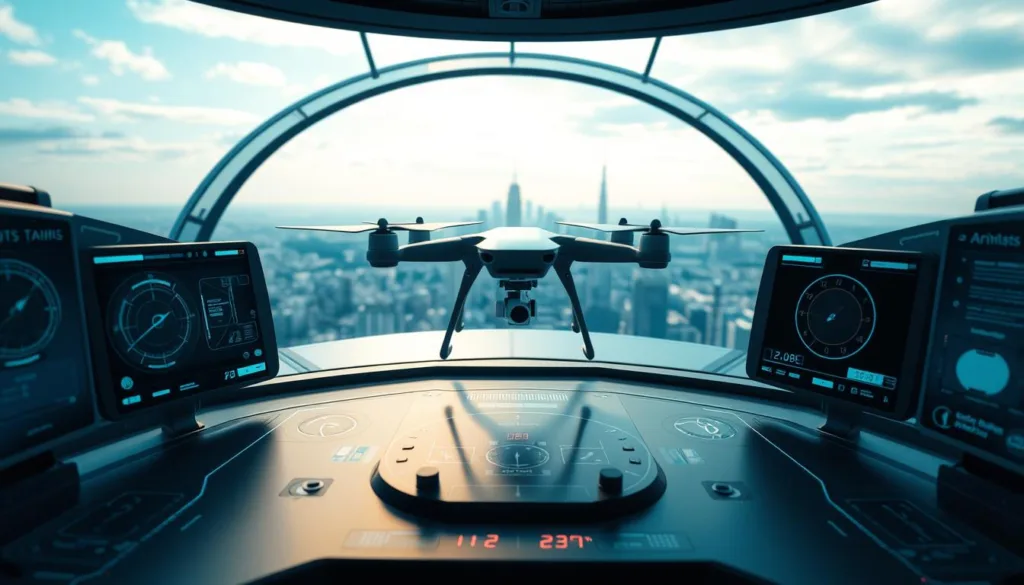Learning to fly can be expensive and risky. Crashing a real aircraft costs money and can be dangerous. This is where modern technology offers a brilliant solution.
Platforms like the SRIZFLY drone simulator create a safe, virtual world for practice. You can develop your piloting skills without ever leaving the ground. This type of training is essential for both new hobbyists and professional operators.
A high-quality simulator bridges the gap between theory and real-world experience. It replicates physics and weather conditions accurately. Users can make mistakes and learn from them in a consequence-free environment.
The SRIZFLY drone simulation software is a leading example of this technology. It helps you master flying techniques for various aircraft, including multicopters and fixed-wing drones. This approach saves significant cost while dramatically improving safety and skill development.
Key Takeaways
- Virtual training platforms provide a safe and cost-effective way to learn how to pilot unmanned aerial vehicles.
- Modern simulators accurately replicate real-world flying conditions and physics.
- These tools are vital for skill development, allowing users to learn from mistakes without risk.
- They are beneficial for everyone from beginners to commercial operators preparing for complex missions.
- Using a simulator can significantly accelerate your learning curve and build confidence.
- Leading solutions offer access to diverse training scenarios and multiple aircraft types.
- The right platform bridges the gap between theoretical knowledge and hands-on flying experience.
Introduction to the Future of Drone Training
Modern technology has transformed how aspiring operators develop their flying abilities through immersive digital environments. These platforms represent the next generation of pilot preparation, moving beyond basic computer programs.
Overview of Simulation Technology in Drones
The evolution of virtual training tools has been remarkable. Early systems offered simple graphics and basic physics. Today’s platforms feature advanced engines that replicate real-world conditions with stunning accuracy.
High-fidelity visual rendering and precise sensor modeling create authentic experiences. This technological foundation allows for meaningful practice sessions. Pilots can build essential skills in a safe, controlled setting.
Why Realism Matters for Drone Piloting
Authentic flight dynamics are crucial for effective learning. When virtual environments accurately mimic real physics, muscle memory develops correctly. This prevents bad habits that could prove dangerous during actual operations.
Realistic training scenarios prepare operators for challenging situations. They can practice emergency procedures without risk. The experience gained translates directly to improved performance with physical equipment.
Quality simulation bridges the gap between theory and practical application. It provides a foundation that accelerates skill development and builds confidence for real-world missions.
Exploring Drone Simulation Software for Realistic Training
The scope of modern virtual training environments encompasses everything from initial design to complex mission rehearsal. These platforms serve multiple purposes beyond basic pilot instruction.
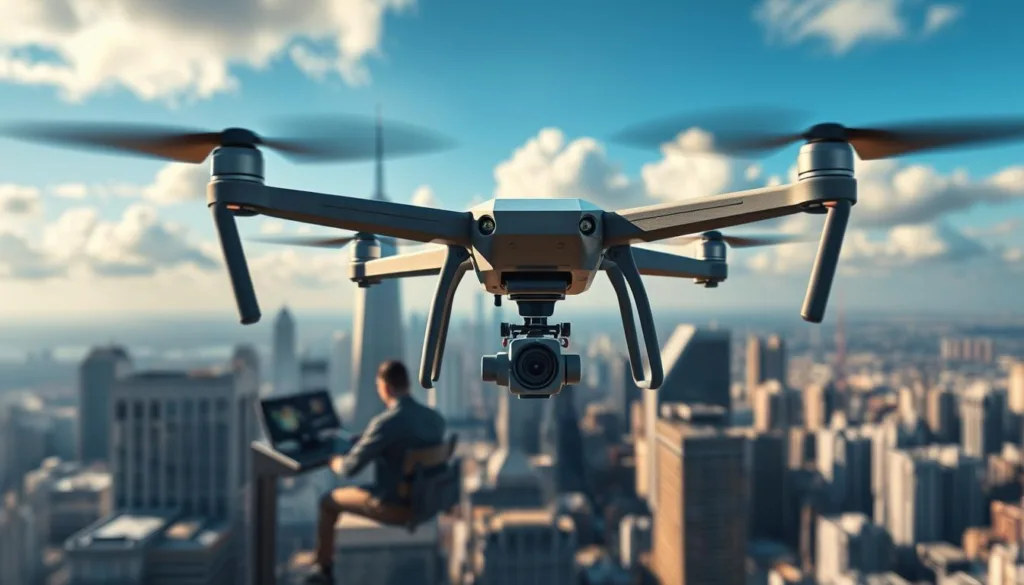
Advanced systems enable users to design unmanned aircraft virtually. They can analyze performance characteristics before building physical prototypes. This approach saves significant development costs.
Realistic training tools use actual flight controller software like PX4 and ArduPilot. The virtual aircraft responds exactly like physical equipment would. This ensures authentic muscle memory development.
Training scenarios range from basic hover exercises to advanced autonomous missions. Operators can practice emergency procedures safely. They gain experience with various configurations including multicopters and fixed-wing designs.
| Capability Area | Primary Function | Key Benefit | Platform Example |
|---|---|---|---|
| Aircraft Design | Virtual prototyping | Cost-effective development | SIMNET |
| Flight Testing | Software-in-the-loop | Risk-free validation | PX4 SITL |
| Pilot Training | Structured courses | Skill acceleration | SRIZFLY |
| Mission Rehearsal | Scenario practice | Operational readiness | AirSim |
These comprehensive tools support the complete development lifecycle. Engineers can refine aircraft designs through iterative testing. The educational value extends to aerodynamics and control systems concepts.
The practical benefits include unlimited practice time and instant reset capabilities. Users can repeat difficult maneuvers until mastered. Mission rehearsal identifies potential problems before actual operations.
Product Roundup: Leading Drone Simulators in the Market
Choosing the right training platform requires understanding the market’s top contenders. Each offers unique strengths for different types of users.
SIMNET: Cloud-Native Platform for Design and Training
SIMNET stands out with its web-based interface. It combines design tools with flight training in one place.
The platform works on any device with a browser. You don’t need a powerful computer. This makes it accessible for students and professionals alike.
Its features include realistic manual and autonomous flying. Users can practice in virtual recreations of real-world locations. The system supports various aircraft types for comprehensive training.
AirSim and Its Open-Source Innovation
AirSim provides a flexible foundation for developers. Its open-source nature encourages customization and research.
The platform integrates with Unreal Engine for stunning visuals. Developers can create specific scenarios through its API. This makes it ideal for technical testing and advanced projects.
Uncrashed: The Ultra Realistic FPV Experience
Uncrashed delivers an exceptional first-person view experience. It’s specifically designed for FPV racing and freestyle practice.
The physics feel incredibly authentic. Many users praise its realism in their review comments. It captures the thrill of actual FPV flying perfectly.
This game-like platform helps pilots build muscle memory safely. The flying mechanics respond just like real equipment. It’s perfect for honing advanced maneuvers without risk.
Cloud-Based Simulation Environments and Their Benefits
Remote server technology now enables sophisticated design and testing capabilities previously limited to expensive hardware. This approach eliminates the need for powerful local computers. Users can access professional tools through any web browser.
Accessing Powerful Drone Design Tools
Cloud platforms provide comprehensive design suites for unmanned aircraft development. Students and small operators gain access to the same tools used by large enterprises. This levels the playing field significantly.
The system handles complex calculations on remote servers. Users can perform aerodynamic analysis and performance predictions. This saves considerable development time and costs.
Real-Time Flight and Environmental Simulations
These platforms offer instant feedback during testing phases. Design iterations happen much faster than with traditional methods. The virtual environment responds in real time to user inputs.
Teams can collaborate on projects from different locations. They share designs and training content seamlessly. The system renders detailed terrain and weather conditions accurately.
Operators can rehearse missions in virtual replicas of actual locations. This prepares them for real-world challenges effectively.
Realistic Flight Simulation and Advanced Physics
What separates basic gaming experiences from professional training tools is the depth of physical accuracy. Modern platforms use sophisticated engines to calculate real-time forces and movements.
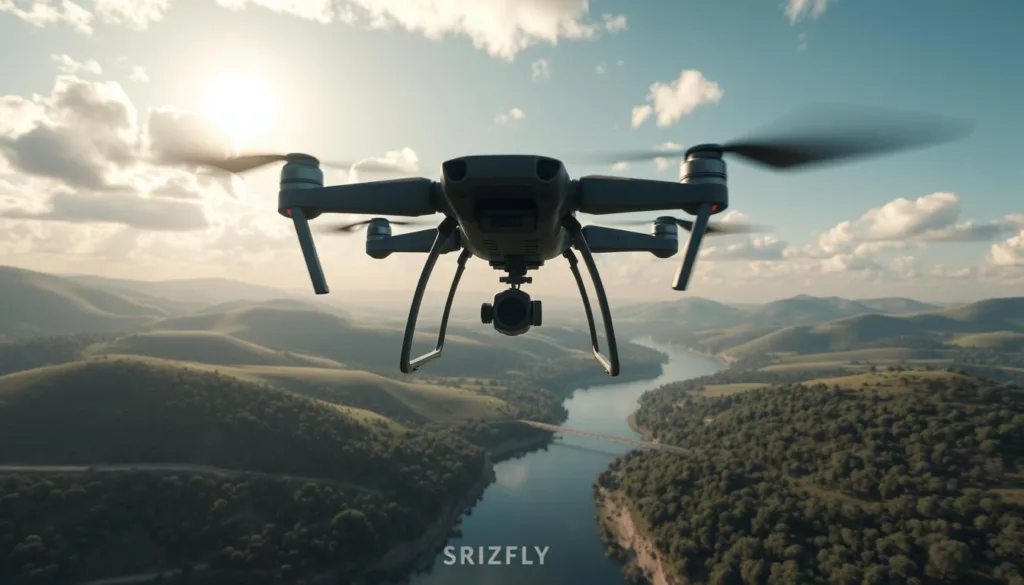
How Simulation Recreates Real-World Conditions
Advanced systems model environmental factors with stunning precision. They calculate wind resistance, air density, and temperature effects. This creates authentic flight dynamics that mirror actual conditions.
The physics engines process complex calculations instantly. They determine how aircraft respond to control inputs and external forces. This level of detail ensures skills transfer directly to real-world operations.
Integrating Physics, Aerodynamics, and Control
Leading platforms combine multiple disciplines seamlessly. They integrate aerodynamic principles with flight control systems. Users can test algorithms and tune parameters virtually.
This integration allows for comprehensive performance analysis. It enables pilots to practice with a wide variety of configurations. The experience builds proper muscle memory and instinctive reactions.
For those seeking professional training, the best PC drone simulator free options demonstrate these advanced physics capabilities. They provide the foundation needed for confident real-world flying.
Enhancing Drone Design, Analysis, and Optimization
Engineering teams now leverage simulation technology to prototype and optimize aircraft designs before physical manufacturing. Platforms like SIMNET provide comprehensive tools that transform how unmanned vehicles are developed and tested.
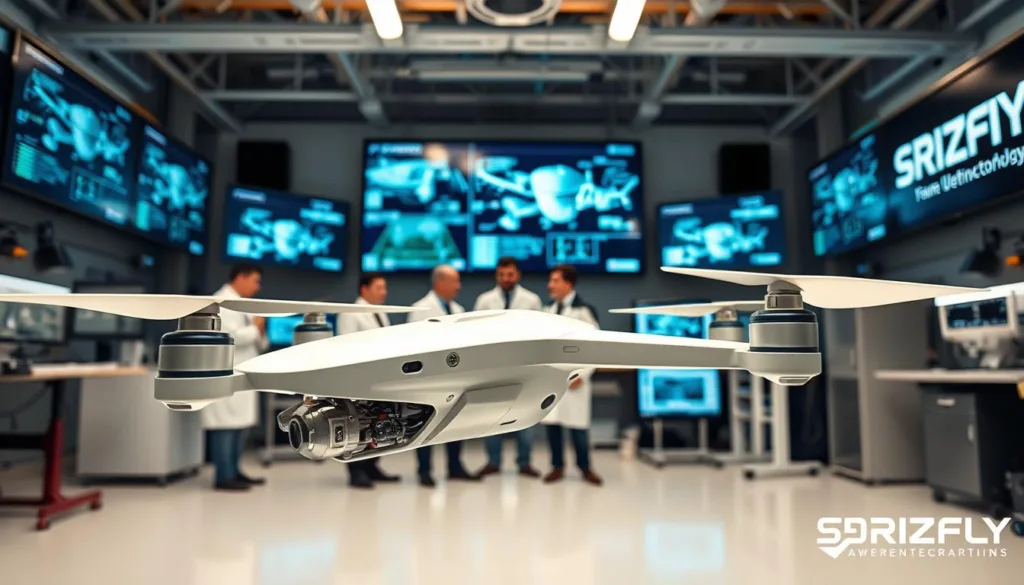
The design workflow begins with selecting components from extensive parametric libraries. Users can quickly assemble various configurations including multicopters, fixed-wing, and VTOL designs. This rapid prototyping capability saves significant development time.
Advanced analysis features provide real-time performance predictions for key metrics. Designers can evaluate flight duration, range, and speed instantly. They compare different design options without building physical prototypes.
Trade study tools visualize how parameter changes affect performance. Adjusting battery capacity or motor size shows immediate impacts on payload and endurance. This helps engineers make informed decisions early in the design process.
Virtual wind tunnel and CFD analysis reveal aerodynamic characteristics. These tools help optimize airframe shapes for maximum efficiency. The ability to export designs to CAD software ensures seamless transition to manufacturing.
This approach dramatically reduces prototyping costs while improving design quality. Teams can identify and fix problems virtually before investing in expensive physical testing. The comprehensive toolset serves engineers throughout the entire development lifecycle.
Virtual Training for Drone Operators and Pilots
Modern training solutions offer structured pathways for operators to build proficiency without physical risk. These platforms deliver comprehensive skill development from basic maneuvers to complex mission scenarios.
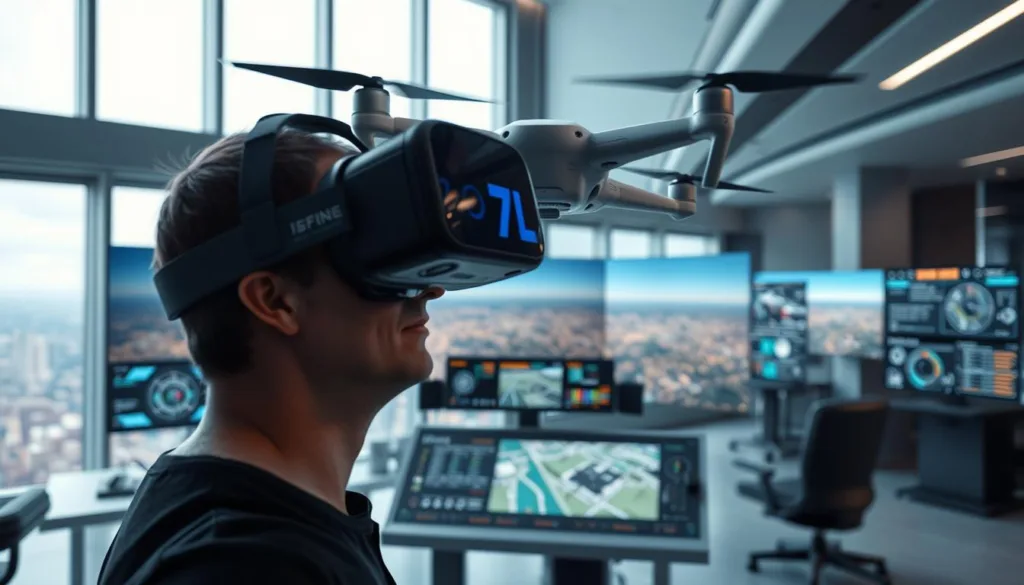
Building and Testing Flight Control Systems
Virtual platforms integrate actual flight control interfaces used in real operations. This approach ensures pilots develop proper muscle memory with the exact systems they’ll encounter.
The training includes hands-on practice with failsafe parameters and emergency procedures. Operators can test new standard operating procedures safely before implementation.
| Training Component | Skill Level | Assessment Method | Primary Benefit |
|---|---|---|---|
| Basic Flight Controls | Beginner | Auto-graded exercises | Foundation building |
| Emergency Scenarios | Intermediate | Performance metrics | Risk mitigation |
| Mission Planning | Advanced | Scenario completion | Operational readiness |
| System Integration | Expert | Real-time feedback | Workflow optimization |
Improving Safety and Readiness Through Simulation
Virtual environments eliminate dangers associated with teaching complex maneuvers. Pilots practice edge-case scenarios like equipment failures and severe weather safely.
Structured programs combine theory with practical exercises that auto-grade performance. This identifies improvement areas without instructor oversight.
SIMNET has become an invaluable tool in my everyday workflow. I lean heavily on SIMNET’s ability to produce accurate results when testing failsafe parameters, new standard operating procedures, flight planning efficiencies, and training footprints.
Periodic retraining maintains pilot proficiency in zero-risk settings. The integrated Learning Management System supports regulatory compliance through documented progress tracking.
Immersive FPV Simulator Experiences for All Skill Levels
First-person view flying brings a unique thrill that demands precise control and quick reflexes. Modern platforms like Uncrashed recreate this experience with stunning accuracy. They help people develop essential skills safely.
Multiplayer and Community Engagement
The social aspect transforms solitary practice into shared adventures. Community features let people race together and learn from each other.
Leaderboards and shared content create friendly competition. This engagement keeps users motivated to improve their flying abilities.

Customizable Settings for Beginners and Experts
Flexible options accommodate everyone from novices to pros. Beginners can start with simplified controls. Experts can fine-tune physics for ultra-realism.
The system supports various input devices. While gamepads work, using a real radio controller provides the most authentic experience. This builds proper muscle memory.
Advanced users can adjust gravity and air friction. These options make the simulator feel like their actual equipment. The community shares thousands of custom tracks for endless variety.
Optimizing Performance with Simulation Recording and Data Analysis
Advanced platforms now offer comprehensive recording features that turn each practice session into a rich source of performance insights. This technology captures every detail of virtual training exercises. Users can replay and analyze their sessions for continuous improvement.
Recording capabilities capture control inputs, aircraft responses, and environmental conditions. Every aspect of the flight is logged with precision. This creates a complete digital record of each training scenario.
The data can be exported as CSV files for detailed analysis. Professionals use third-party tools to examine performance metrics. This approach helps identify patterns in drone behavior and pilot technique.
Instructors create better training content based on recorded data. Developers validate designs by comparing predicted versus actual performance. The objective metrics replace subjective assessments.
This combination creates a powerful learning loop. Mistakes become valuable lessons without real-world consequences. Performance optimization happens faster through data-driven insights.
Advanced Simulation Technologies: AR, VR, and Beyond
Cutting-edge interfaces are transforming training by blending digital information with real-world perspectives. These technologies create deeply engaging learning environments that accelerate skill development.
Integrating Virtual Reality into Drone Training
Virtual Reality completely immerses users in digital worlds. Platforms like SIMNET support VR using Meta Quest headsets for accessible experiences.
This technology provides first-person perspectives with full head tracking. It enhances spatial awareness and situational understanding significantly.
The state pane feature offers real-time monitoring during simulations. Users gain comprehensive awareness of system status throughout their training.
Exploring Augmented Reality Interfaces
Augmented Reality overlays flight data onto the pilot’s view. This creates heads-up displays similar to advanced aircraft systems.
Different controller options work with these interfaces. From traditional radio controllers to hand tracking, users have variety in their setup choices.
These technologies make simulator experiences more realistic and effective. They represent the future of immersive training environments.
How Simulation Software Fuels Innovation in Drone Development
The democratization of advanced design tools has opened unprecedented opportunities for innovators worldwide. Students and startups now access technology once reserved for major corporations.
This accessibility fuels rapid experimentation. Teams can test bold concepts without financial risk. The virtual environment encourages creative problem-solving.
Industry leaders recognize the transformative impact. One developer shared, “SIMNET has become an essential part of our workflow. The ability to visualize flight dynamics in real time gives us insights we simply couldn’t get from static tools.”
| Innovation Area | Traditional Approach | Simulation Advantage |
|---|---|---|
| Prototype Testing | Weeks/Months | Instant Validation |
| Cost per Iteration | Thousands of Dollars | Minimal Expense |
| Team Collaboration | Geographically Limited | Global Participation |
| Risk Assessment | Real-world Failures | Virtual Safety |
The technology meets emerging industry needs effectively. As delivery services become reality, platforms adapt to support complex operational requirements.
Students from Technical University of Munich confirm the impact. “SIMNET helped us visualize flight behavior and refine our design before touching real hardware.”
This approach lowers barriers for people worldwide. It creates a more inclusive innovation ecosystem where great ideas can flourish regardless of funding.
Conclusion
Today’s training tools bridge the gap between theoretical knowledge and hands-on flying experience. They offer safe, cost-effective practice for pilots at every skill level.
The platforms we explored—SIMNET for comprehensive design, AirSim for open-source development, and Uncrashed for FPV racing—each serve distinct needs. Their realistic physics and diverse features create authentic training environments.
Pilots can gain valuable flight time without risking expensive equipment. The right choice depends on your specific goals, whether you’re into racing games or professional missions.
Using a proper controller builds muscle memory that translates to real-world flying. The growing FPV community shares positive reviews about these tools.
Ready to start your journey? Explore SRIZFLY’s drone simulator solutions today. As technology advances, these training environments will become essential for meeting the needs of pilots worldwide.
FAQ
What is the primary benefit of using a drone simulator for training?
The main advantage is safe, cost-effective skill development. Pilots can practice maneuvers, master flight control, and learn in various virtual environments without the risk of damaging expensive equipment. It builds muscle memory and confidence efficiently.
Can I use my own radio controller with SRIZFLY or other simulators?
Yes, most modern simulators, including SRIZFLY, support a wide variety of real radio controllers. You can typically connect via USB, which provides a much more authentic and responsive training experience compared to using a keyboard or gamepad.
How realistic is the physics engine in today’s flight simulators?
The realism is exceptionally high. Advanced simulators use sophisticated physics engines that accurately replicate aerodynamics, weight, wind effects, and even battery drain. This creates a training environment that closely mirrors real-world flying conditions.
Are there good FPV drone simulators for beginners?
A> Absolutely. Many platforms, like Uncrashed, offer customizable settings. Beginners can enable stability aids, reduce simulation speed, and practice in open environments. This allows for a gradual learning curve before tackling more complex FPV racing or freestyle content.
What is the difference between a cloud-based simulator and a desktop application?
A cloud-based simulator, like SIMNET, runs on remote servers, allowing you to access powerful design and simulation tools from any computer with a good internet connection. A desktop application is installed locally on your machine, which can sometimes offer more consistent performance for intensive real-time flight simulation.
Can simulation software help with professional drone development and testing?
Yes, significantly. Engineers use these tools for drone design, analysis, and optimization. They can test flight control systems, analyze performance data, and simulate how a new model will behave in different scenarios long before building a physical prototype, accelerating innovation.
Do any simulators offer multiplayer or community features?
Many do. Multiplayer modes allow pilots to race or fly together in the same virtual world. A strong community often shares custom maps, drone models, and settings, greatly enriching the overall experience and providing endless new content to explore.
How does virtual reality (VR) enhance drone simulation training?
VR integration creates a deeply immersive experience, especially for FPV training. It places you directly in the pilot’s seat with a true first-person view, improving spatial awareness and reaction times. This technology is a powerful tool for advanced pilot readiness.

